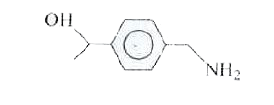Glycerol →KHSO4[A]→LiAlH4[B] which of the following is
not B
Allyl alcohol
Acrolein
Acrylic acid
None of these
The correct Answer is:B,C
To solve the problem step by step, we need to analyze the reactions that occur when glycerol is treated with KHSO4 and then with LiAlH4.
Step 1: Understanding Glycerol
Glycerol (C3H8O3) has the following structure:
CH2OH|CH|CH2OH
It contains three hydroxyl (-OH) groups.
Step 2: Reaction with KHSO4
When glycerol is treated with KHSO4, which is a dehydrating agent, it removes water molecules. The reaction can be summarized as follows:
- Dehydration Reaction: Glycerol loses two water molecules (H2O) to form an intermediate compound.
The reaction can be represented as:
Glycerol(C3H8O3)→Acro≤∈(C3H4O)+H2O
The product formed here is acrolein (CH2=CH-CHO), which is unstable and will undergo tautomerization.
Step 3: Tautomerization of Acrolein
Acrolein can tautomerize to form:
CH2=CH−CHO(Acro≤∈)↔CH2=CH−COH(unstab≤form)
However, acrolein itself is the primary product formed from the dehydration of glycerol.
Step 4: Reaction with LiAlH4
Next, acrolein reacts with lithium aluminium hydride (LiAlH4), which is a strong reducing agent. The reaction can be summarized as follows:
- Reduction Reaction: Acrolein is reduced to form allyl alcohol.
The reaction can be represented as:
Acro≤∈(C3H4O)+LiAlH4→AllylAlcohol(C3H6O)
The product formed here is allyl alcohol (CH2=CH-CH2OH).
Step 5: Identifying the Products
Now, we need to identify which of the given options is not product B. Based on the reactions:
- A (the product after KHSO4) is acrolein.
- B (the product after LiAlH4) is allyl alcohol.
Conclusion
From the options provided, we can conclude:
- Acrolein is product A.
- Allyl alcohol is product B.
- Any compound that is not allyl alcohol is the answer to the question.
Thus, the answer to the question "which of the following is not B" is acrylic acid, as it is not formed in the reaction sequence.
Glycerol (C3H8O3) has the following structure:
CH2OH|CH|CH2OH
It contains three hydroxyl (-OH) groups.
When glycerol is treated with KHSO4, which is a dehydrating agent, it removes water molecules. The reaction can be summarized as follows:
- Dehydration Reaction: Glycerol loses two water molecules (H2O) to form an intermediate compound.
Glycerol(C3H8O3)→Acro≤∈(C3H4O)+H2O
The product formed here is acrolein (CH2=CH-CHO), which is unstable and will undergo tautomerization.
Acrolein can tautomerize to form:
CH2=CH−CHO(Acro≤∈)↔CH2=CH−COH(unstab≤form)
However, acrolein itself is the primary product formed from the dehydration of glycerol.
Next, acrolein reacts with lithium aluminium hydride (LiAlH4), which is a strong reducing agent. The reaction can be summarized as follows:
- Reduction Reaction: Acrolein is reduced to form allyl alcohol.
Acro≤∈(C3H4O)+LiAlH4→AllylAlcohol(C3H6O)
The product formed here is allyl alcohol (CH2=CH-CH2OH).
Now, we need to identify which of the given options is not product B. Based on the reactions:
- A (the product after KHSO4) is acrolein.
- B (the product after LiAlH4) is allyl alcohol.
From the options provided, we can conclude:
- Acrolein is product A.
- Allyl alcohol is product B.
- Any compound that is not allyl alcohol is the answer to the question.
Topper's Solved these Questions
Similar Questions
Knowledge Check
- Question 1 - Select One
Carbon-oxygen double bond are easily reduced by NaBH4orLiAlH4. The actual reducing agent in these reduction is hydride ion (H−).

The metal-hydrogen bond in LiAlH4 is more polar than metal-hydrogen bond in NaBH4. As a result LiAlH4 is strong reducing agent than NaBH4. Esters, carboxylic acids, amides cannot be reduced by NaBH4.
The carbonyl group of amide reduced to methylene group by LiAlH4.
Find the correct product of the following reaction :
 A
A B
B C
C Dno reaction
Dno reaction - Question 2 - Select One
GlycerolKHSO4−−−−→ALiAlH4−−−→B.
A and B are :Aacrolein, allyl alcoholBglyceryl sulphate, acrylic acidCallyl alcohol, acroleinDonly acrolein (B is not formed) - Question 3 - Select One
If a≠2, which of the following is equal to b(a2−4)ab−2b ?
AabBaCa+2Da2
Let matrix B=[41−9−2] then which of the following will not be an element of matrix B100 300 (2) 301 (3) −299 (4) 100
View Solutionif set B ={1,4,8,16,32,64} then which of the following is true? If not then mention why?
(i) 4∈B
(ii) 16∈B
(iii) 2∈B
( iv) 164∈BView SolutionLiAlH4 is used as :
View SolutionFor two events A and B, if P(A)=P(AB)=14 and P(BA)=12, then which of the following is not true ?
View SolutionWhich of the following expressions is equivalent to 2a+4b+6c ?
View Solution

